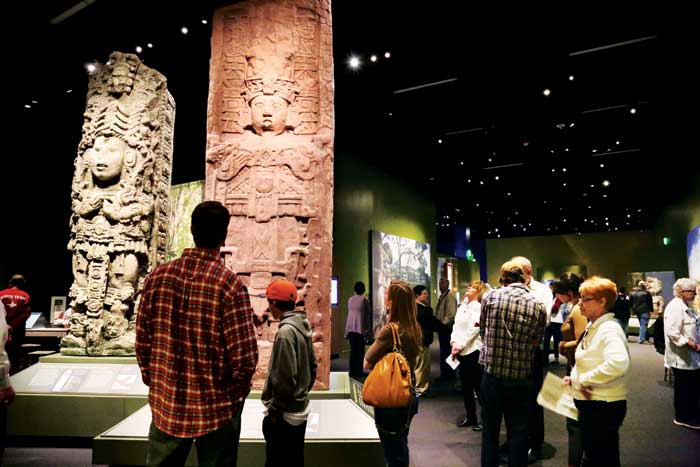
Large stone slabs called Stelae from 731 AD map out the Maya territory.
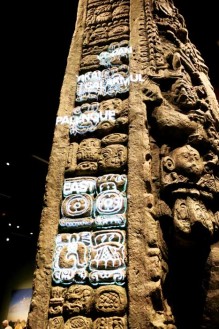
Ceiling lights illuminate the meaning of glyphs (Maya script) and images found on Stelae.
Colorado residents are among the first to get to know their neighbors to the south—way south— through the first exhibition to be held in the new Morgridge Family Exploration Center at the Denver Museum of Nature & Science. “Maya: Hidden Worlds Revealed” examines the Maya culture, which Michele Koons, PhD, curator of archeology, feels is exciting not only because it was a very advanced, ancient civilization, but because of the culture’s close proximity to Colorado, a nonstop flight away. “It’s very foreign in some ways, but we’re also so close geographically that it’s exciting and actually quite accessible. People can be enticed by what they see here.”
Working with the Science Museum of Minnesota, the exhibit represents the first time the Denver Museum of Nature & Science has co-created a traveling exhibition. The two museums collaborated with institutions across the U.S. and with antiquities entities in Belize to select 250 artifacts, making it the largest exhibition on the Maya ever to be displayed in the U.S.
Members of the museums’ teams went to Belize to experience sites firsthand. “We traveled into watery caves in the dark with headlamps on and up into the higher areas where ritual sacrifices occurred,” says Jennifer Moss Logan, lead educator for the exhibition. “We had the experiences for ourselves so that’s why we can bring them so realistically through our environment to our visitors.”
In addition to artifacts, there are also replicas to touch and interact with. Images are projected onto two tall replicas of “Stelae,” outlining the details of the glyphs, displaying the Mayan language and the translation, making it easier for visitors to understand what they are seeing. In another room, colors are projected onto a large, gray replica of a temple. Originally very colorful, the light “virtually paints (the temple) to restore it to show how it would have looked,” says Moss Logan. 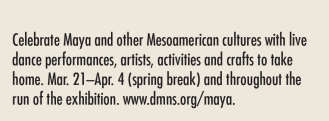
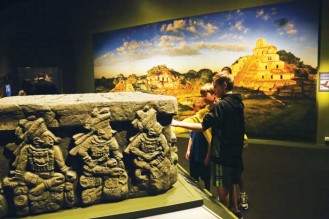
Altars such as this one are found at all Maya sites. The altars commemorated important occasions and served as the place for elaborate sacrifices—including human offerings—to the gods.
Although intended for the whole family, Moss Logan says children ages 8 and older will appreciate recurring mathematical themes, so important to the Maya. Throughout the exhibit, visitors can spot artifacts with dots representing the number 1 and long bars representing the number 5. Children can put their birthdate into the Maya calendar or create their Maya name to print out and take home.
There are also opportunities for kids to build things, see what Maya life was like and see games played with the first rubber balls. Volunteers are positioned throughout the exhibition to share information, answer questions and guide activities at Exploration Stations.
The entire exhibit is bilingual, a salute not only to the Maya people but also to the large Mexican and Central American populations in Colorado.
In one room, visitors can pretend to be archeologists, virtually excavating an actual tomb. Using a large touch screen, dirt can be brushed away revealing skeletons and artifacts underneath. Notes about what the items are, as well as pages from archeologists’ actual notebooks from the site become visible. “It’s completely, scientifically accurate, so the excitement of discovery can be had by the entire family without ever having to get a fingernail dirty!” Koons says.
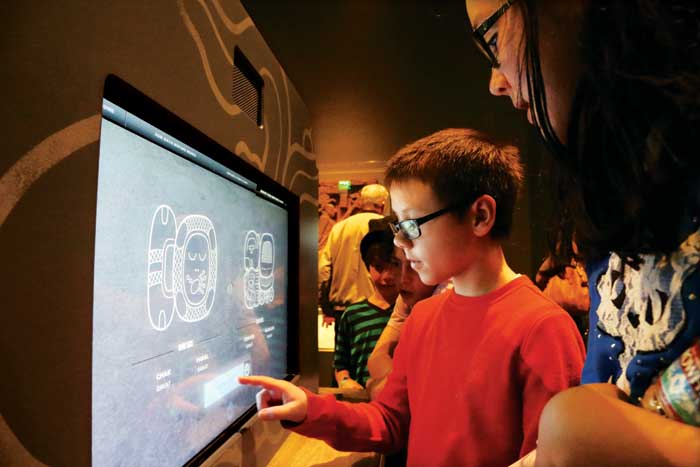
Interactive screens allow museum-goers to write their own Maya name by combining glyphs. Visitors can hear the name by pressing an audio button.
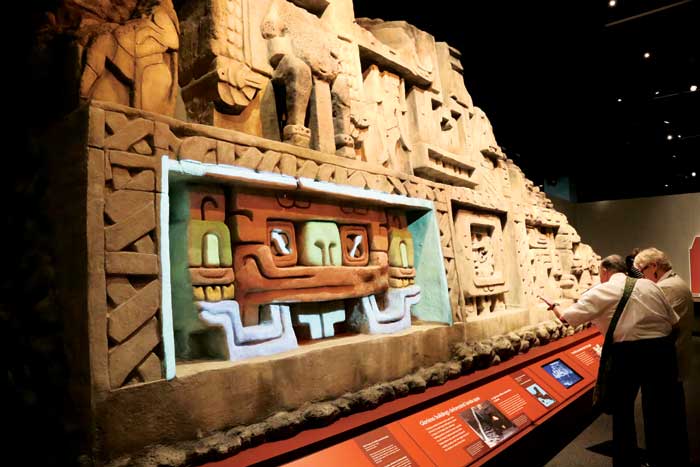
Ceiling lights show how the Maya structures were originally brightly colored.
That glimpse into the science of archeology is deliberate. “We highlight the steps we (archeologists) go through to make these discoveries and how different techniques are being used to get more information about the past to reflect on what we’re doing today,” says Koons, citing the Mayan’s deforestation of their landscape that eventually contributed to the downfall of the classic Maya.
The message of archeological preservation is present throughout the exhibition. “Looting of sites is a huge problem throughout the whole world, so it’s really important to instill how important it is to preserve them through exhibitions like this,” says Koons.
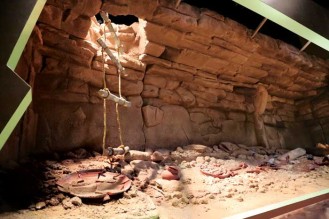
A large burial pit (for what must have been a prestigious Maya noble) stores treasures for the afterlife.
“Maya: Hidden Worlds Revealed” is the inaugural exhibition to be held in the Center’s new combined Anschutz Gallery and adjoining Phipps Special Exhibits Gallery. Either gallery can hold its own exhibition or can join to create 20,000 square feet of space for larger exhibits such as this one.
“Maya: Hidden Worlds Revealed” debuted at co-creator’s Science Museum of Minnesota and will be in Denver until August 24. It will then travel to the Museum of Science, Boston and San Diego Natural History Museum. The hope is that the exhibit will continue to travel around the U.S., which will bring revenue to the Denver Museum of Nature & Science. “Visitors will have a chance to experience an incredible culture from the past that continues on through today,” says Moss Logan. “We’re very proud.”
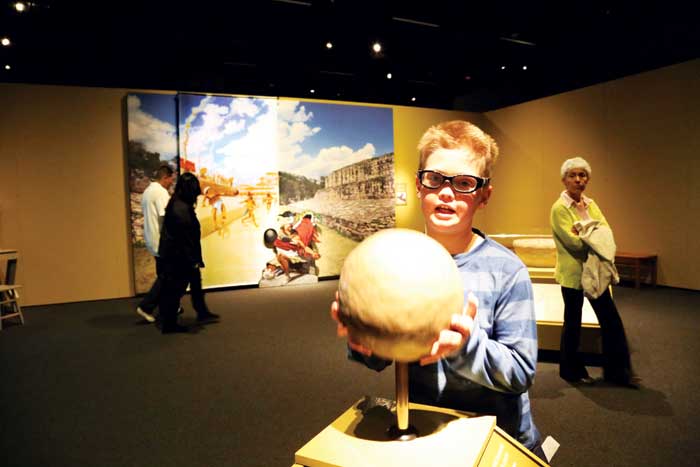
A young museum visitor lifts a heavy rubber ball like those used in a Maya game resembling basketball.
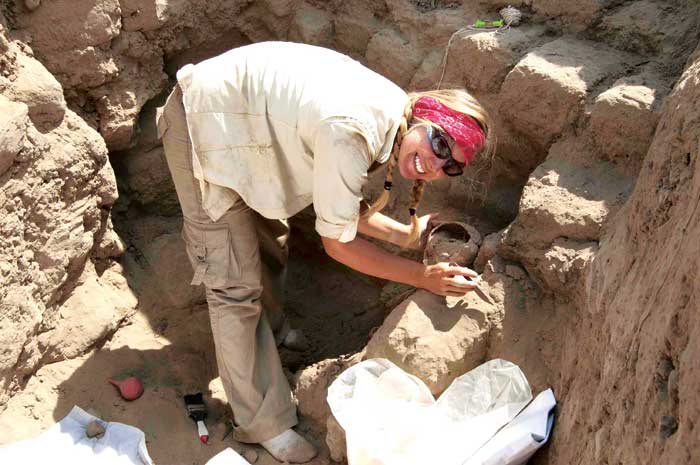
Michele Koons, DMNS curator of archaeology, works on an excavation site.
“Maya: Hidden Worlds Revealed” is a ticketed event with discounts for museum members.



0 Comments